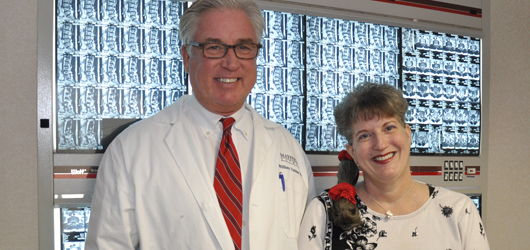
Valerie had been struggling with severe low back pain for about two weeks when her condition reached a tipping point. Awakening in the early morning hours to use the bathroom, Valerie discovered that her entire pelvic area was numb. Shocked but not overly alarmed, Valerie went back to bed.
Later that same day, she was still numb and now becoming increasingly concerned. Still, she was able to begin the day as planned, driving herself to Mercy Mt. Airy Hospital for a medical appointment unrelated to her back pain and unexplained numbness. But Valerie barely made it from her car to the hospital door.
“I was gasping, short of breath, and the pain in my back was very bad,” Valerie recalls. “I had terrible numbness in the ‘saddle region,’ and at this point, I felt so heavy. The pain and numbness went down the back of my right leg to my kneecap and underneath my foot. I was in excruciating back pain.”
By the end of her appointment, Valerie could not take another step. She was taken to the emergency room in a wheelchair.
The hospital’s emergency department team, recognizing the signs of a spinal emergency, ordered an MRI. The MRI confirmed their suspicions: Valerie had suffered a massive disc herniation in her lower back. The disc was protruding so severely that it had created an emergency situation known as cauda equina: a compression of the bundle of nerve roots that extend below the spinal cord like the tail of a horse. (Cauda equina means horse’s tail in Latin.) These nerves transport messages to and from the pelvic organs, legs and feet, and if they remain squeezed for too long, permanent damage can occur. That can mean incontinence, permanent loss of sensation in the pelvic area, and paralysis.
Read Valerie’s complete story and learn more about cauda equina and a support group opportunity >>